Summary
This article outlines how XB Software created a custom online booking and scheduling system for a salon chain — replacing messy spreadsheets, calendars, and legacy tools with a unified platform that manages clients, staff schedules, appointments, and analytics in one place. The solution improved efficiency, reduced administrative burden, boosted customer satisfaction, and enabled salons to offer 24/7 online booking, automated reminders, and real-time availability for both clients and staff.
Modern software systems offer features that help automating business processes of almost any type. Unfortunately, due to the lack of knowledge about the current state of the software market, some organizations continue to use a set of separated tools, sometimes obsolete, instead of a single integrated software solution. The situation is also relevant for salons that use appointment and booking systems. It is vital to know that such an approach should be reworked significantly so that it won’t cause tons of redundant data and the necessity to verify information stored in different applications.
According to the Research and Markets report, the Global Appointment Scheduling Software Market is projected to grow at a CAGR of 9.24% during 2022- 2027. Therefore, to understand how to deal with the occurring challenges, let’s look at the real examples. Our developers provided the chain of salons with a full-featured online booking system, which allowed company management to overcome the mentioned issues. And this is what we offered.
Key Challenges a Client Faced While Using Obsolete Salon Software
First of all, let’s look at what our customer came to us with.
- They wanted a solution in the form of a custom booking system for beauty salons. This software should increase the overall performance and eliminate the shortcomings caused by the used approach.
- They used a set of separate tools. It resulted in low productivity and decreased customer satisfaction. For example, to monitor the salon appointments, employees used Google calendar. To handle all the clients’ info the legacy software with an Excel-like user interface was used.
- The used approach stopped working. The scheme worked just fine when there were only a couple of clients, but during the times of peak activity, salon employees had to deal with many disadvantages of such an approach. For example, the time required for clarifying the booking date and customer information was above acceptable limits.
- Customers didn’t have access to the system. Without access to the online salon booking system, clients had to provide the required information by phone, usually during the working hours. It also did not add any enthusiasm to either side.
Tired of putting up with this state of affairs, the customer requested our software development company to build a user-friendly online booking system for the chain of salons. The solution should enable users to book and schedule salon appointments easily. The staff, in its turn, should be provided with the possibility to manage client relationships using a detailed appointments history, record of preferences, notice of future bookings and contact details.
Read Also Boosting up Your Salon Business with an Online Booking System
Steps We Followed to Develop the Best Solution
The problem of each client that comes to us is heard. We always try to offer the best solution so that they will be pleased with the result. Therefore, we gathered our team of different specialists and started to look for the solution that will help our customer to overcome the existing shortcomings.
Step 1. Research and Issue Analysis
First, our business analysis team made scrupulous research of software that the customer’s chain of salons used. In general, to ensure the best possible outcome, our company uses two sources of knowledge:
- We rely on data from open sources. Our company continually monitors current trends in web application development to provide cutting-edge solutions for modern problems.
- We use the info gathered during our cooperation with all our previous customers. We know what challenges modern beauty salon businesses face and which features company management most usually wants to get. Moreover, feedback received from customers and continuous support after the product delivery allow us to analyze the decisions we made and correct our development methodology if needed.
Taking into account the information received from a customer, our business analysts decided to provide a booking system for salons that will both present new features and won’t cause confusion among employees. When company staff have to deal with a new application that has an unfamiliar user interface and overloaded with features, instead of increased productivity, you can face frustration and the need for extensive training in the use of the software.
Our business analysts asked a simple yet key question:
“What is the basic component, both familiar and simple to use, around which we can build a comprehensive booking system for salons?”
The answer was more straightforward than it seemed. Since the salon workers have already used Google calendar to manage salon appointments, why not provide our customer with an online booking app that has a similar user interface? So be it.
Step 2. Planning and Deciding on Features
At first, the plan was to create an online booking system for salons with the basic functionality. Then, add features one-by-one to help the employees gradually get used to the new functionality. We had to develop an advanced online scheduler with a calendar that would enable salon employees to control the schedule of the specialists, create or cancel appointments, and correct the existing data if needed.
The plan looked great, but a booking calendar couldn’t cover all the needs of a beauty salon with dozens of clients. Therefore, our business analysts offered some additional features to be implemented after the successful adoption of a new booking system.
Besides helping company employees to deal with appointments, the system also should provide potential clients of the beauty salon with a mechanism of booking that would be more convenient than a phone call or email.
Clients should be able to choose the specialist and service using the appointment form. Using the booking system, they would create appointments and see the information about their own bookings. To improve the management process, we decided to implement features allowing employees to analyze KPI and visualize the data in an easy-to-understand way.
According to all this info, the following list of essential booking system features was decided:
- clients can book a visit to the salon to a particular employee;
- clients of the salon can choose a time period in which a specialist is free;
- employees can review the records and create the new ones if needed;
- administrators can get easy access to a client’s name and contact info;
- administrators can see the statistics on every salon’s employee such as the number of working hours during the week, month, or a year. It allows assessing the staff performance.
Read Also Hair and Beauty Salon Business Strategy You Can’t Ignore
Step 3. Wireframing and Choosing the Right Tools
It can look great on paper, but the question is how this online booking solution for salons will look on the screen. At the very first stages of development, our designers created a mockup that allows getting an overview of the future application.
The next step was to choose the tools that will guarantee the best outcome. It was decided to use the DHTMLX UI library. Considering that an application is supposed to have an intuitive calendar and be available for both employees and customers, using DHTMLX Scheduler as the primary development tool for the project was the best choice.
DHTMLX Scheduler is a JavaScript event calendar component with a wide range of view layouts. With the help of this JavaScript calendar scheduler, it is possible for users to check scheduled events by day, week, month, or year and create new ones.There is also the Map view that shows the location of an event on Google Maps. As a result, it is easier to make and manage appointments both for salon employees and customers.
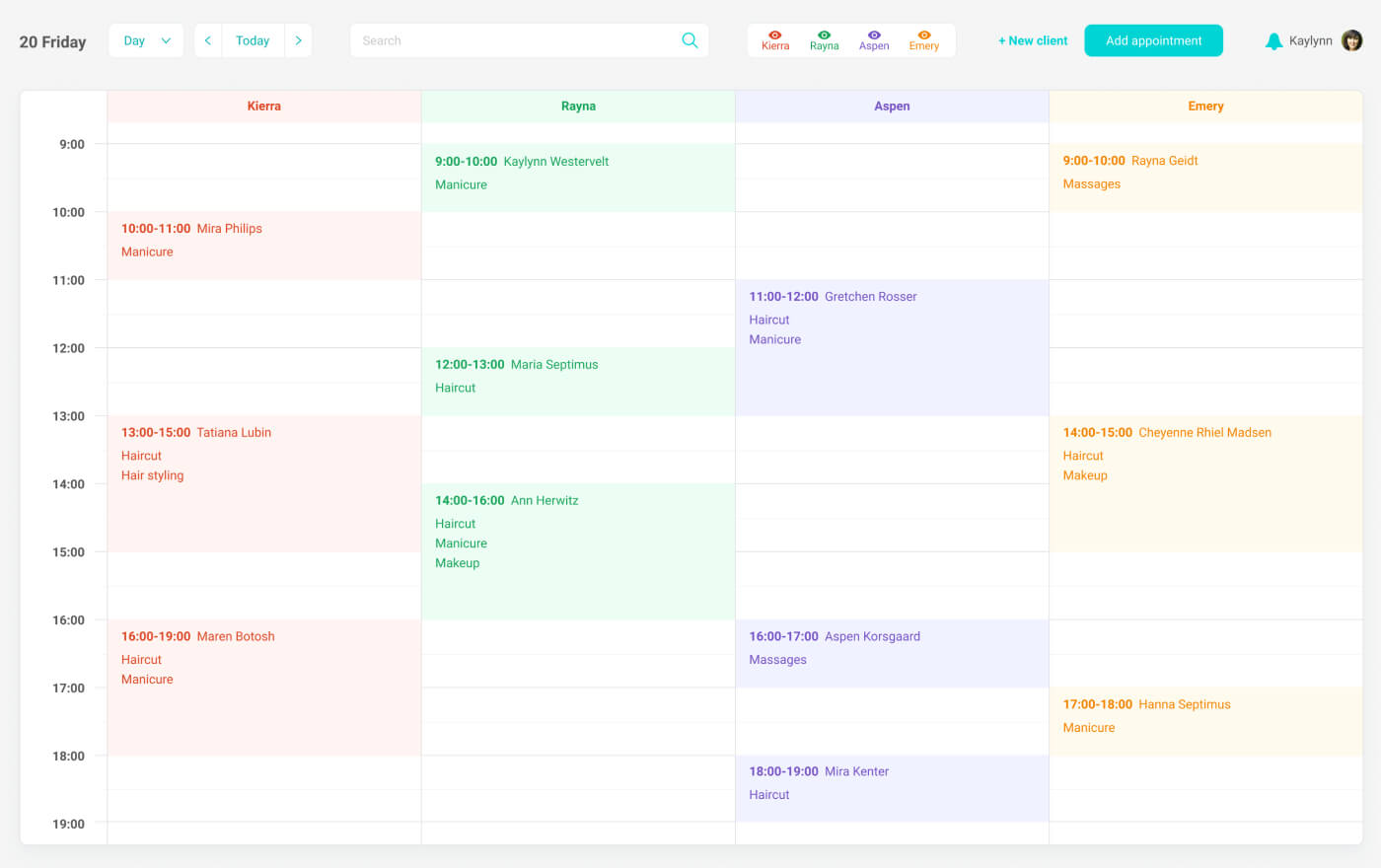
Source: Intuitive Online Appointment Scheduling System for Salons
The library provides rich JavaScript API and extensive opportunities for customization which is precisely what we needed. From the customer’s perspective, this component is also an excellent choice since it provides broad functionality at a relatively low cost, which eventually had a positive effect on the overall price of the project.
Step 4. Providing a Client With a Custom Solution
After all the discussions with the client, our development team has created an online booking system for salons that consists of 3 main parts:
- a page for managers;
- a page for clients;
- a dashboard.
Staff members can change appointment time and duration, add comments, and re-assign tasks to each other. Salon managers can set working hours, day-offs, and holidays. The ability to create a list of available services and set the average time to complete them allows calculating the duration of each session with ease.
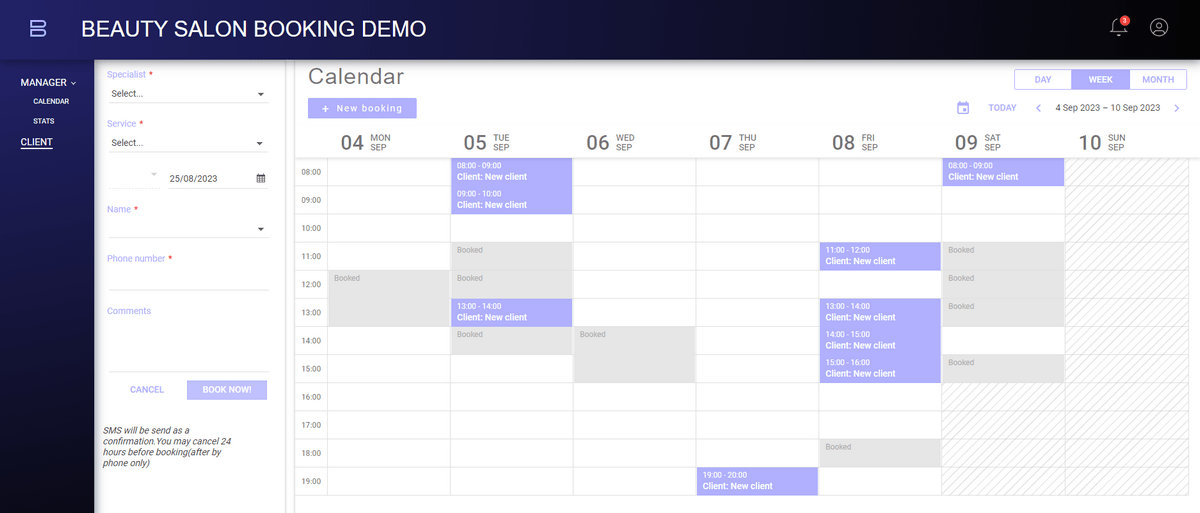
For salon clients, the booking system calendar shows available appointment slots and available specialists across different salon locations. It allows users to choose a particular specialist and service with a couple of clicks. For all bookings, cancellations, or reschedulings the booking system automatically sends reminders to staff and clients and synchronizes all notifications between customers and salon employees.
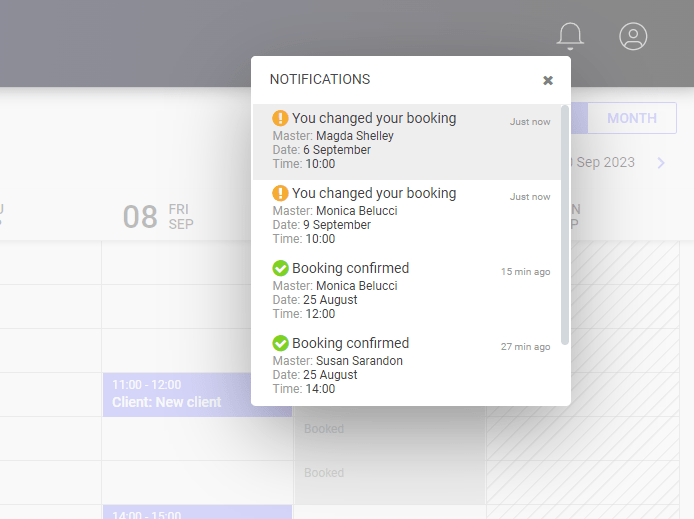
Besides that, our developers have integrated a booking dashboard into the system. It allows salon managers to achieve better visibility of their metrics, which helps the business to optimize the revenue.
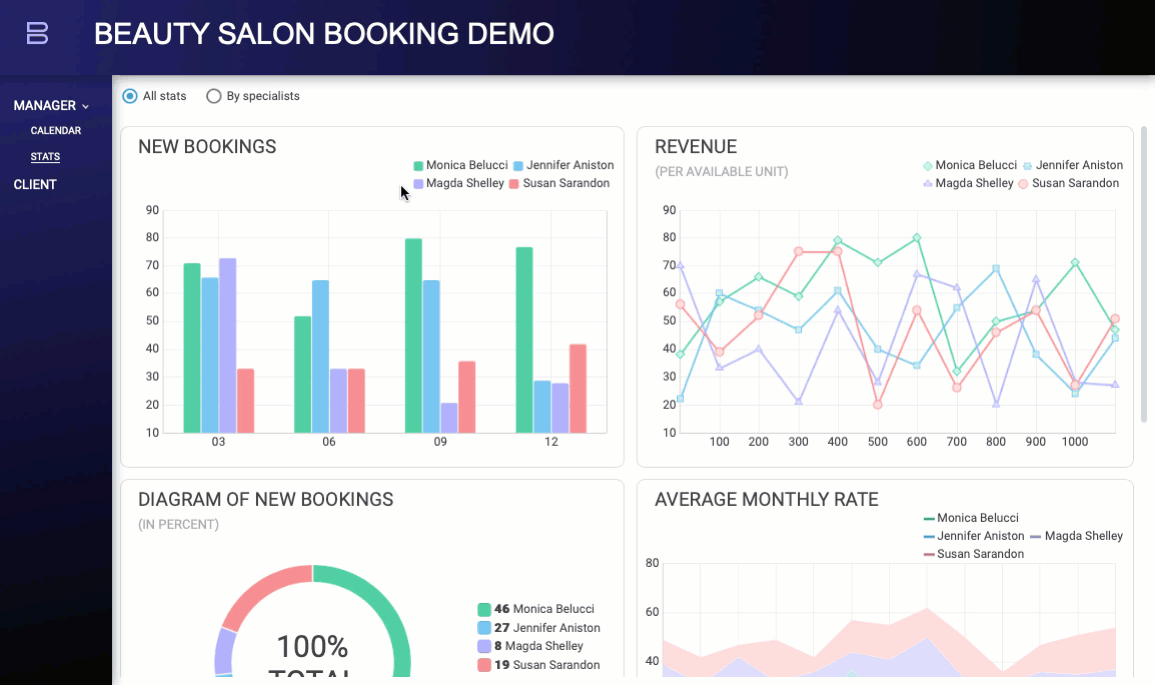
The dashboard contains widgets that provide the following information:
- New bookings by employees. The features allows reviewing the percentage of bookings that are assigned to a particular specialist;
- Occupancy rate. It shows total occupancy percent for each month;
- Revenue per unit and average revenue. This information allows to assess the overall financial performance as well as the contribution of each employee;
- Average monthly rate by specialist. It gives better insight on the monthly rate.
Step 5. Testing and Release
As a result, we developed a web application and its mobile version to let different types of users manage appointments. Our developers created an easy-to-use and efficient online appointment booking application for a hairdressing salon that helps the management, planning, and booking of the appointments. Our QA and software testing team ensured that the system works flawlessly and is ready for the release.
According to the data and feedback gathered from our client, the adoption of a booking system has provided the following benefits:
- simplified and accurate time management;
- automated scheduling;
- easy access to KPI.
After the first month of using the salon booking system, company employees noted higher work satisfaction and decreased the number of tasks to be performed manually. After the clients got the opportunity to reserve an appointment with a particular specialist with a couple of clicks, the customer satisfaction and willingness to reuse services have increased significantly.
Alternative Solution for the Network of Salons
Our expertise of developing custom salon booking software doesn’t stop with just a demo and one app. We know that every client has their own goals, and not every one of them requires the system that will deal with both sides of end-users, covering the needs of employees and customers. Some businesses have to manage an entire network of salons. Therefore, we also want to showcase a demo that is ideal in such a case.
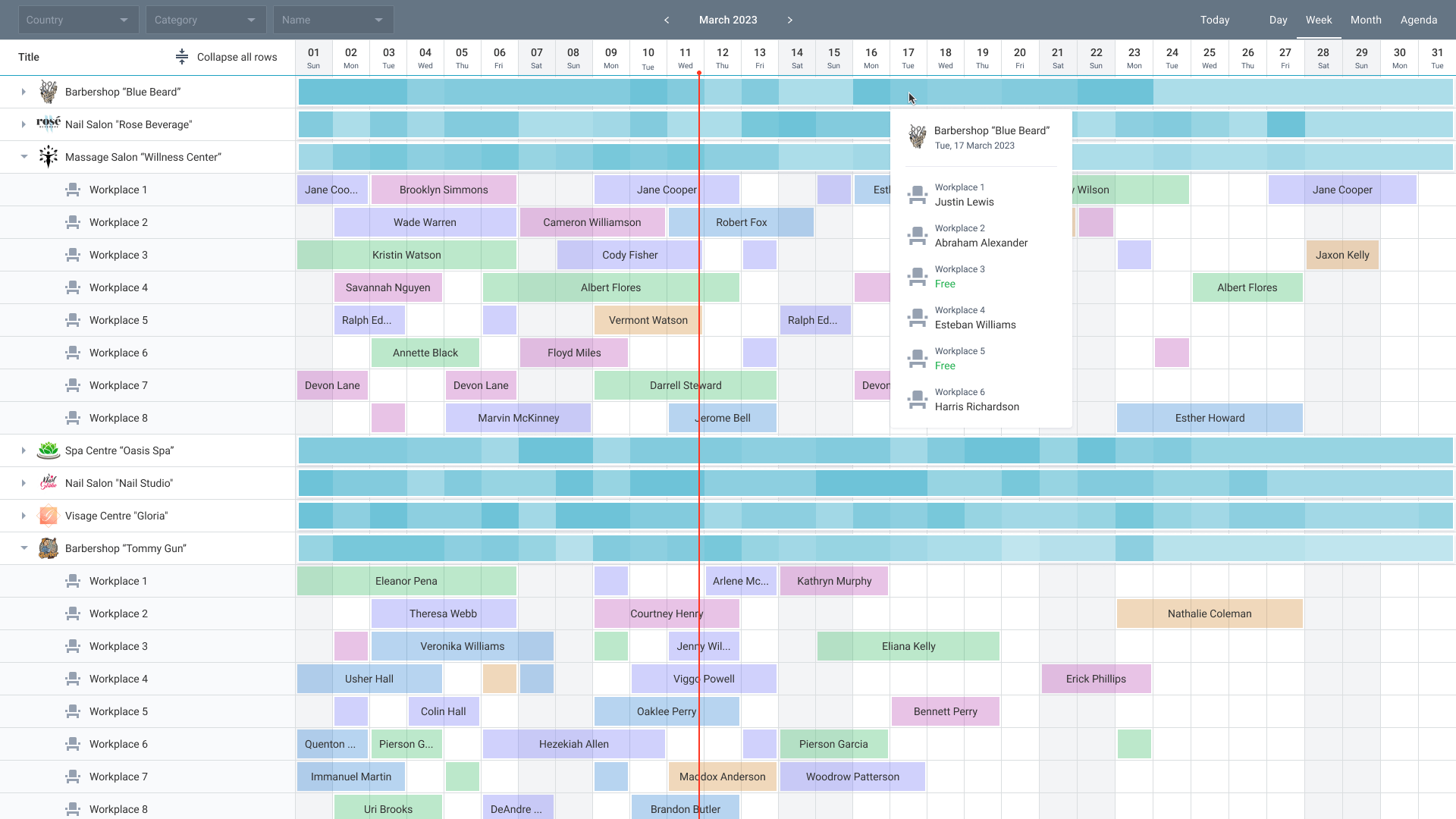
There was a need to offer a booking software solution that would simultaneously see the full number of workplaces and advertising station load for each of the beauty shop centers and, at the same time, allow you to see a detailed picture of the loading of each workplace and advertising station in the form of a timeline.
By using a complex Webix Gantt widget, we created a tool that makes the visualization of operational activities and business processes more user-friendly. The component was able to help with the following:
- Pace workplaces and advertisement stations from different companies on a timeline area. Physically, each of workplace and station depends on particular placement and period of renting (dates scale);
- Decompose the data for better visualization. We had several beauty centers and the amount of data increased several times. So, firstly, data had nesting – a list of beauty salons with a list of workplaces and advertising boards inside. Secondly, as in reality it can be a large amount of data, it is better to load it in parts, and not in one piece. We understood that performance is a crucial moment for us and started to work with it.
- Perform big data immediately, without time gaps. Initially, it loads a list of beauty centers. It does not immediately display information about the workplaces or advertisements boards on screens, but it can show the occupancy of the salon. We open a branch and load a list of screens related to this beauty center.
- Visualize the totals and the details on the same screen. There is no need to open each branch to see if there are any empty dates in renting workplaces or advertisement boards. The branch shows it by colored areas on the bar: from 100% occupancy of all stations during the day, week, or month that is deep colored to less than 100% occupancy that is colored lighter.
- Specify the data during global data visualization. Additional filters help to display data on one specific screen, on the type of screen in different beauty shops, if there is such a type, on a specific company.
Read Also Best JavaScript Libraries for Data Visualization (Featuring Webix and DHTMLX)
Conclusion
To keep up with the modern needs, it is essential to come up with modern solutions. Therefore, if your appointment software is not as new and shiny as it was before, customers aren’t really satisfied with using it, and your business processes become slower, maybe it’s time to turn the page and start anew. If you want to learn more about custom-made booking software for salons and benefits it can provide, please contact us, and our specialists will be glad to help.